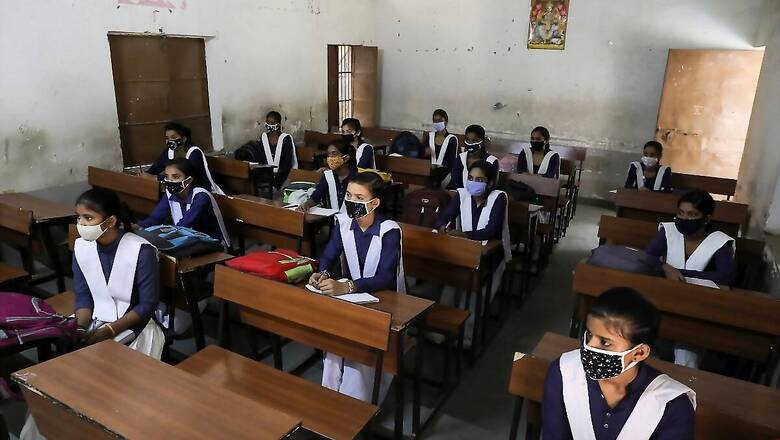
views
“Brahmanism could taunt you with the mask of nationalism, flaunt itself as Ramana Maharshi, beseech you with its invocations of Saivism, implore your attention as Vaishnavism. It could assume the countenance of a rishi and demand the thumb of the Ekalavya.” This was the warning, just eight days after Independence, from the Periyar-edited newspaper, Viduthalai (V. Geetha, 2013).
The combination of nationalism and Brahmanism was always feared for its knack to inflict continued exclusion. The Ambedkar-led Drafting Committee ensured that the Constitution of India, especially the Fundamental Rights of the citizens and the Directive Principles of State Policy, together, rather than the moralities of Brahmanism, define the relationship between citizens and the state. But, the recently adopted National Education Policy (NEP) 2020 has the audacity to not mention the Fundamental Rights or Directive Principles. The policy does mention three times the Fundamental Duties. At other times, the Constitution is referred to only for mentioning official language schedules.
The NEP 2020 does not find it relevant to mention the term ‘secular’, while detailing 30 tenets (section 4.28) to literally ‘redefine’ the term ‘constitutional values’. This redefining is followed immediately to reconfirm what it really means. It states, “Children will have the opportunity to read and learn from the original stories of the Panchatantra, Jataka, Hitopadesh, and other fun fables and inspiring tales from the Indian tradition.” It adds an ‘also-statement’, saying, “Excerpts from the Indian Constitution will also be considered essential reading for all students,” just to reiterate that the reading of the Constitution is secondary.
The policy, however, has detailed sections on Sanskrit language: initially promoting Sanskrit as language; then, promotes ancient texts written in Sanskrit, which invariably are texts that cemented Brahmanism since the past; and then institutionalise Sanskrit into the education system. The policy then states, “The rich heritage of ancient and eternal Indian knowledge and thought has been a guiding light for this Policy” (page 4). The education policy of 1986 also had an entire section on Sanskrit and Indology (section 36), but the section whenever used the term Sanskrit, had mentioned other classical languages as well. It did not want to, explicitly, give podiums to Sanskrit. However, in the 2020 policy, the use of the term, eternal, surreptitiously, brings the Sanatan (dharma) knowledge system into the policy (Nivedita Menon, 2020). The Sanatan knowledge system influenced national heritage may not be as innocuous as one thinks, especially, at these times, when the term, secular, is used by the governor of Maharashtra to taunt the chief minister, even, in official communications.
It is not that the policy architects are not aware of the obligation for promoting equity in education. The NEP 2020 begins with acknowledging one, that “education is fundamental for developing an equitable and just society” (page 3); and two, that “providing universal access to quality education” (page 3) “is must for India’s leadership in the global stage”.
However, the NEP ignores the three undeniable trends. One, across elementary and secondary stages, the dropout rates for SC and ST are way above that of the general category. Two, the disparity is also increasing over the years. Three, the public expenditure on education is falling, and the cost is borne by the schemes that are of the nature of targeted affirmative action. Between the years 2014-15 and 2019-20, the share of education expenditure in the total union budget fell from 4.1% to 3.4%. And between 2015-16 and 2019-20, the scholarship allocation for SCs fell continuously from Rs 843 crore to Rs 355 crore, a decline of 58%. As a result, the number of beneficiaries under the scheme fell by 94% (from 340,000 in 2015-16 to 20,000 in 2017-18). These three trends show that the disparity based on caste and gender is increasing. The policy fails to confess that the education system is prejudiced against the marginalised categories.
Ignoring the equity considerations, the policy comfortably assimilates global capitalism. It seeks to calibrate the education system to cater to rapidly changing global demands of skilled labour. It acknowledges the risk: “Many unskilled jobs worldwide may be taken over by machines”(page 3), but it also reasons that there would be growing demand for a skilled workforce to engage with technological development, climate science and infectious disease management. It backs ‘flexibility’ in the education system, that is, appropriate to various needs and requirements; and creates ‘choices’ for students to access courses, subjects, languages, schooling and credit system of their choice.
However, the education system, inherent of its corporatism, caste system, patriarchy and conservatism, would be ‘leading’ students to make certain choices; and the system of choice and flexibility is just a façade to hide the continued domination of rich, while theoretically providing equal choice and flexibility to all.
The policy recognises “the social status hierarchy associated with vocational education” (section 16.4) when it states, “Vocational education is perceived to be inferior to mainstream education and meant largely for students who are unable to cope with the latter. This is a perception that affects the choices students make.” But, nowhere it has stated any plan to address it. Instead, instinctively, the NEP is actually preparing a mass of job-seekers, among the marginalised, to be on the vanguard fighting with the machines, dumped by global capital, that are going to take over most of these jobs associated with vocational skills, But those from dominant castes, with all their privileges, are being prepared to spearhead the country’s leadership in machine learning, artificial intelligence and data analytics. The potential moving away from the English medium would cost the first and second-generation learners among the marginalised. The market will thus reproduce the caste system, with full patronage from the NEP.
The policy responsibility to create political citizenry to stand up for the fundamental rights of all citizens is pronounced by its absolute absence. A number of laws that assaulted patriarchy and the caste system became possible because of the efforts of a number of feminist and anti-caste movements in the last six decades.
However, the NEP, in fact, seems to have vindictively expunged the terms, ‘patriarchy’ or ‘caste system’. It does not talk about the affirmative actions in recruitments of people into the education system or need for sex education in the school curriculum. In fact, the NEP prescribes students to read ‘original’ stories of the traditional fables, and not the feminist or anti-caste reading and interpretation of the same. The emphasis on so-called ‘original’ is aimed to erase any non-Brahminical version from the curriculum, created by Dalit-feminist authors.
The absence of a rights-based narrative in the education policy is a deliberate attempt to depoliticise the immediate stakeholders: students and teachers. No entitlements flow to them. It determinedly refrains from speaking about student unions and associations, teachers unions and association and the role of trade unions and workers associations; or the participation of these associations in management decisions or creating a democratised student bodies in the universities.
Further, the power of the state governments has also been truncated. It creates central agencies like the National Curriculum Framework for School Education, National Curriculum Framework for Teacher Education and National Testing Agency; and then prescribes common examinations for class 3, 5, 8, 10 and 12. It abolishes existing regulatory bodies such as UGC, AlCTE and NAAC, and unites them under one all-powerful centralised body. Federalism was compromised when, even before NEP 2020 was presented in the Rajya Sabha or any consultations were organised with chief ministers, the Conference of Governors on NEP was organised in September 2020.
Exactly 100 years ago, in the year 1920, under the British rule, a newly formed self-government in the Madras Presidency enacted the Madras Elementary Education Act, 1920. The non-Brahmin-led Justice Party enacted the law to eliminate inequalities based on gender and caste, to remove urban bias, while upholding the principles of decentralisation and secularism. Its significance lies in the fact that by 1926-27, about 84% public schools were opened for Panchamas and 38.5% schools were actually admitting them.
Paradoxically, in the 21st Century, in independent India, we have an education policy, which neither aims at eliminating inequalities based on gender and caste, nor upholds the principles of federalism and secularism. It does mention socially and economically disadvantaged groups (SEDG).
Even, there are certain schemes for communities at margins. Periyar once stated, “Today Brahmins do not mind losing anything as long as they claim the status, title and influence which accrue to only the highest caste. To possess this status, they do not mind doing anything, will behave in any which way and yet consider such acts the highest forms of dharma. Thus, Rajaji will eat at the Panchama’s house, Shankaracharya will bathe on seeing a Panchama, some will bathe if a Panchama’s shadow falls on them, others if a Panchama touches them. Yet others will marry a Panchama, man or woman – but all of them will still remain Brahmanas.” As stated by Periyar, these schemes do provide for allowances, but without challenging the caste system and patriarchy.
The Constitution of India abolished untouchability, but it did not abolish the caste system. In the government spaces, caste-Hindus flaunt non-religious, neutral and even a caste-less posture. But they use the concepts of freedom of choice, individual freedom and private space to preserve the markers of castes, and associated rituals and status. Many continue to practice untouchability: employing their own caste person as cook at home or for their weddings; or proudly stating their caste in matrimonial advertisements. Caste-based associations, federations, companies, restaurants and hotels are flourishing. The way NEP has been written shows that Brahminism no longer even requires the mask. The ministry of culture-appointed committee, now, has representation from the private World Brahmin Federation. The casteism could now be paraded in the government and policy spaces as well. The National Education Policy is less an education policy, more a tool that uses the instruments of nationalism and capitalism to curate the rule of religion to substitute the rule of law, till the religion again becomes the law.
Read all the Latest News, Breaking News and Coronavirus News here




















Comments
0 comment